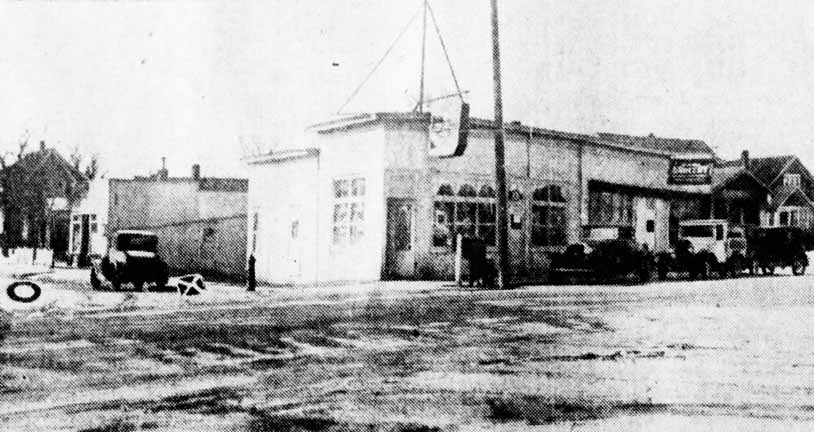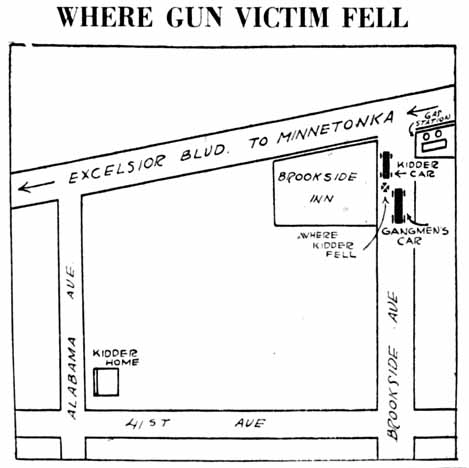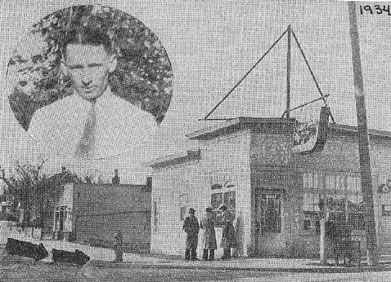On March 4, 1934, perhaps the most sensational event in Brookside history took place when local resident Theodore Kidder was gunned down next to what would become Brookside Drug. That may be the only fact that everyone can agree on.
DUELING THEORIES
For decades, this has been an unsolved crime, full of speculation. One has Kidder a member of the local crime syndicate who got on the gangster’s wrong side, while another is emerging that makes him out as an innocent victim of a road rage incident with the wrong fellas. Let’s explore both.
KIDDER AS GANGSTER
Many of the following details for this section were provided by Mrs. Alta Johnson, a niece of Ted Kidder. Mrs. Johnson has told her story on a program about Baby Face Nelson that aired on the Biography Channel on February 9, 1998. She has also graciously provided copies of family pictures of Kidder to the St. Louis Park Historical Society.
35-year-old Kidder was originally from Council Bluffs, Iowa (also reported as LaCrosse, Wisconsin) and was survived by a brother, E. Dean Kidder of St. Paul. He had spent most of his life in St. Paul, and was an avid sportsman, fisherman, swimmer, and hunter. He married Bernice (rhymes with furnace) Duxbury in about 1926.
He worked as an ammunition salesman for the National Lead Company, 102 West Fairfield Ave., in St. Paul. He also worked other part time jobs, one in particular at the Kennedy Brothers Arms Company. St. Paul in the 1930s was a known haven for gangsters, and Mrs. Johnson said that Kidder was associated with them, playing golf with them and procuring ammo for them on the side.
Around this time the St. Paul sales office of National Lead was merged with the facility in St. Louis Park, which would explain why Kidder had moved to 4081 (then 4055) Alabama in St. Louis Park in about October 1933. Incidentally, his wife had recently left the Glen Lake Sanitarium after a five-year bout with tuberculosis, and probably knew nothing of her husband’s gangster activities.
For whatever reason, his former associates were not happy with him, and the gunmen were looking for him that night. Neighbors reported that a large sedan had circled his block several times, flashing a light on his house each time. Another car found him on Chicago and Lake, where Kidder, his wife, and mother-in-law Effie were driving home from a child’s birthday party in Minneapolis. Four men in fedoras in a blue Hudson with California plates bumped Kidder’s car from behind, leading his wife to believe the men were angry about the fender bender.
The men in Fedoras followed Kidder home, and when he saw that they were still there, he drove around the block. He pulled over on Brookside Ave., and the Hudson pulled in behind him. Kidder walked to the back of his car and had words with one of the men who had also exited his car saying, “Come over here, Ted, we want to talk to you.” After their “talk,” one of the men in the car pulled out his gun and shot him through the window with 17 copper-jacketed .32 caliber bullets. Three of the bullets made their mark. Kidder’s mother-in-law screamed “What have you done?” and the gangster shouted “Keep your damned mouth shut or we’ll give it to you too.” [or “Shut up, old lady, or we’ll get you too.”]
The car sped off backwards down Brookside Ave. toward 41st Street and went west on 41st, as observed by “Jack” Thomas, 4090 Brookside Avenue. Mrs. Kidder went for help inside the Brookside Inn, a cafe and confectionery run by C. Wesley Smith – the building would later be known for years as Brookside Drug. Kidder was carried inside by Smith and two 17-year-old neighbors Robert Nylander (4301 Yosemite) and Carl Mohlin (3950 Alabama). Bullet holes penetrated the side of the stucco building, and proprietor Smith was pictured in the Minneapolis Journal pointing them out. Kidder died in the Inn.
The women had no choice but to return home, and the press descended on them, even to the point of trying to climb in the bathroom window. Mrs. Kidder and her sister moved back to Minneapolis shortly afterwards. Mrs. Kidder eventually lived in the Episcopal Hall in St. Paul, and never spoke of the incident, except that she was once heard to say, “I should have asked more questions.” She never remarried, and died at age 87. Theodore Kidder is buried in Lakewood Cemetery.
Although the killing took place in St. Louis Park, the case was investigated by the County Attorney’s Office. There were few clues to the shooter at the time, although the FBI traced the car with California plates to James Rogers, an alias used by Baby Face Nelson.
MOTIVES
Speculation as to the motive ran the gamut:
- One theory was that Kidder was suspected of snitching on the perpetrators of the St. Louis Park Post Office robbery of 1933 that sent two men to Leavenworth. This theory actually made it to the Minneapolis Star on March 7, 1934.
- Some said that that Kidder might be some kind of Government agent and that the incident was being hushed up.
- One man attributed the incident to a shoot-out between rival beer distributors.
- Relatives were pretty sure that it was just a case where he had gotten over his head, and could not meet increasing demands.
- One retired St. Louis Park cop saw similarities between the murder of Kidder and that of Walter Liggett, who was followed home in his car and gunned down before his wife and family on December 9, 1935. Kid Cann was tried in that case and acquitted.
Evidence that the killing was assumed to be gangland-related was when St. Louis Park Mayor Kleve J. Flakne called a meeting shortly afterwards “to form a committee of vigilantes to cooperate with police in a war on lawlessness.” Flakne was quoted as saying, “In my opinion, members of our vigilantes should be deputized, and should be given orders to shoot to kill in event of any crime.” Plans were made to purchase a machine gun for the police department and put the entire village under citizen surveillance at all times. (Minneapolis Star, March 9, 1934)
Such a drastic move was taken on the heels of the Kidder murder, but had been considered for some time, as the Park was becoming known as “Little Cicero,” after the working class suburb of Chicago where Al Capone moved his gang in 1923 to escape reformers. In addition to the Post Office robbery of 1933, a safe stolen in the mail robbery of the St. Paul Union Depot was found in a local sand pit – see 1933 above.
THE ROAD RAGE THEORY
In 2003, Bryan Burrough wrote a book called Public Enemies that drew on several sources not previously available to the public. These include:
- Interviews with former FBI agents
- Review of recently-released FBI files (nearly one million pages)
- A manuscript surrounding Dillinger’s final weeks
- Unpublished interview transcripts that Alvin “Creepy” Karpis gave before he died
- Unpublished manuscripts by several FBI agents
Here is Burrough’s account of the Kidder murder:
The night Dillinger arrived in the Twin Cities, Nelson was driving through Minneapolis with his gofer Johnnie Chase when the two cut in front of a car driven by a thirty-five-year-old paint salesman named Ted Kidder, who was returning from a birthday party with his wife and her mother.
“Damn it, they can’t do that to me,” Kidder said as Nelson’s car veered in front of him.
Irritated, Kidder sped up and cut back in front of Nelson’s Hudson. This enraged Nelson. He pulled alongside Kidder’s car and attempted to force it into the curb. Kidder pulled ahead, but Nelson stayed directly behind him as they neared the salesman’s home in the St. Louis Park section of Minneapolis. Not wanting to lead the angry driver to his house, Kidder headed toward a drugstore to call the police. Reaching the store, he had just leaped out of his car when Nelson drove up and shouted something.
A moment later three shots rang out. Two struck Kidder in the midsection, and he fell, dying.
His wife, Bernice, ran to his side.
“You’ve killed him!” she screamed.
“Keep your damn mouth shut,” Nelson snapped, “or I’ll let you have it, too.” He backed up the car and drove off.
This was John Dillinger’s new partner.
Also this:
In a 1941 series of articles for True Detective Adventures, Nelson’s friend Fatso Negri quoted Nelson’s version of the Kidder murder. “[W]e happened to cut in ahead of another car,” Nelson said. “The driver, one of those fresh guys, cut right back in front of us. He stopped the car, got out, and came back toward us and said to me: ‘What the hell do you mean? Get out of that car and I’ll slap your face for you.’ He had taken a step or two toward us when I leveled on him and hit him. Then we had to tear out of that place.”
THE NEWSPAPER’S VERSION
- Kidder was actually a paint salesman (Dutch Boy lead-based paint was made by National Lead) and had been for ten years. He had nothing to do with bullets. However, an unexploded cartridge was found in his pocket, and his employment at National Lead was given as a possible explanation as to how it could have “found its way” there.
- It was consistently reported that there were five men in a large, new car with California plates.
- Kidder was used to driving fast.
- The mother-in-law noticed the car still following but didn’t say anything until he noticed when he was almost home.
- The building where Kidder stopped, probably to call the police, was the Brookside Inn, a cafe and confectionery

- Kidder stopped on Brookside Ave. and the other car stopped behind him.

- Kidder got out and said something to the occupants of the other car. The women in Kidder’s car also got out but didn’t hear what was said.
- Alternately, as Kidder got out, someone in the other car called to him, and he was shot as he turned toward the other car.
- A weapon was poked through an open window of the offending car. This would imply that none of the five men actually got out of the car?
- Three shots were fired and two hit Kidder in the abdomen. Later it was reported that all three bullets hit him in the abdomen, and he had four bullet holes in him.
- Initially reported as .32 caliber, the bullets were later described as copper jacketed .38s. They were described as short nosed, fired from an automatic pistol, and of an unusual type.
- As he was shot, his hat fell off, he collapsed against the rear of his car, and slumped to the ground.
- The mother-in-law screamed “Oh what have you done!”
- One of the men yelled back, “Keep your dammed mouth shut or I’ll let you have it, too!”
- Kidder’s wife ran toward the door of the Brookside Inn and yelled “My God, they shot him!”
- Witnesses at the Brookside Inn said that one of the men wore a light hat and the other was fairly young. Later they said they all looked pretty young.
- The killers rounded the block, got back on Excelsior Blvd., and headed west.
- The initial theory was mistaken identity. This theory was backed up by a similar incident reported on the same night, at Glen Lake, west of the shooting. A car with five men pulled up to another car similar to Kidder’s, took a look inside, and then pulled back. The driver had been driving erratically. (Minneapolis Star, March 6, 1934)
Differences between Burrough’s version and the newspapers are:
- It describes two men (Nelson and Johnnie Chase) in the car, while the newspapers describe five men.
- It describes the building as a drug store (which it later became) instead of a cafe. (The building was redone in 1952 but is still there.)
- He has the wife running toward Kidder instead of toward the Cafe.
- He has Nelson yelling at the wife instead of the mother-in-law
Newspaper reporting wasn’t perfect, but the stories were pretty consistent from one day to another. But generally, you get the picture.
So what do you think? Was Kidder a gangster or just a poor guy who accidentally took on Baby Face Nelson with his car?
For additional information on crime in St. Louis Park, see Police and Crime.

